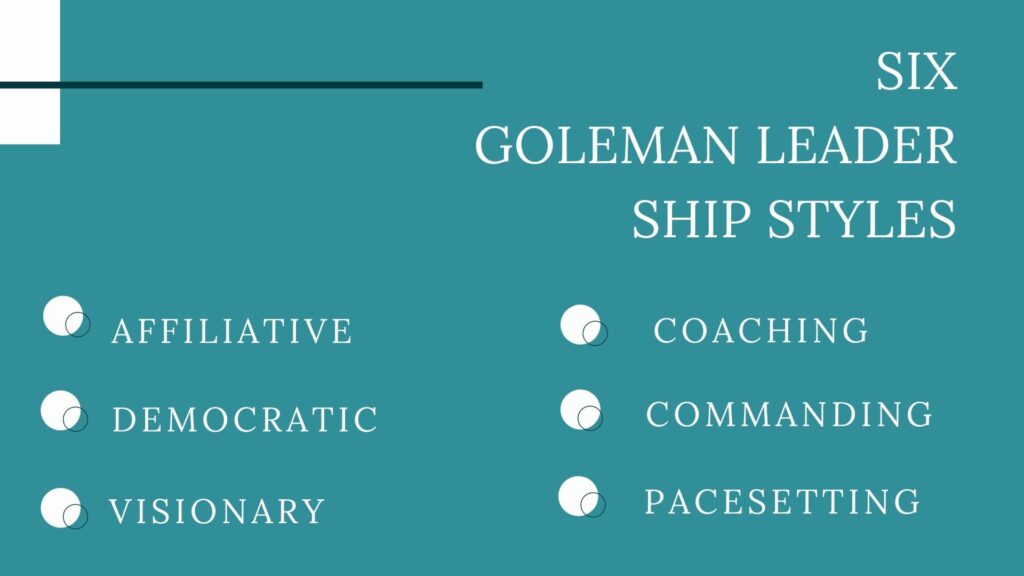Emotional intelligence is one crucial factor in leadership. The “father” of emotional intelligence, Daniel Goleman, in 2002, formulated Goleman’s six leadership styles. His book Primal Leadership was based on understanding different aspects of emotional intelligence in leadership.
Each one of them exists and is very dependent upon the explicitness. Altogether interrelated yet so different in behaving emotions. All six of them have their purpose. It distinguishes them from the form of leadership. Specific leadership is required for particular solutions.
Not every company will be ordering one that means commanding. Some can follow the path of empathy; they need another leadership style. So Goleman distributed each one of them in different styles and explained them precisely. In his book, he made sure he describes each of them with accuracy so that people can make a choice easily as emotional intelligence is vital for any style.
Its purpose is to provide leaders with the indispensable abilities to choose which leadership can benefit their organization. Also, what they can do when they’re stuck with confusion and can’t find solutions to it. This explanation makes them aware of what they require. Also, they can switch in between the leadership if the current one isn’t working for them.
What are Goleman’s Six Leadership Styles?
1. Affiliative
As the audience is the priority; thus, it believes in creating harmony and building emotional bonds to establish a healthy and prosperous environment.
2. Democratic
This style emphasizes on what you feel, as an individual. It relies on consensus through participation and based on the opinions generated, decides the result.
3. Visionary
This sort of style sees leaders who lead teams according to their vision. A visionary leader always summons people towards an idea and convinces them to follow him.
4. Coaching
A leader following this style involves coaching his members timely. He believes in preparing them for the future and gives them a platform to try things and explore new ideas.
5. Commanding
This style can be seen as “Do as I say”. The team revolves around the leader as his word is the last. Usually, it doesn’t bother to listen and straightaway demands agreement.
6. Pacesetting
A leader who adopts this style aims at reaching targets before the deadline. They like maintaining a constant pace. This way, they manage to set high standards for performances.
Explanation of Goleman’s Six Leadership Styles

1. Affiliative
This leadership style is about encouraging others. A leader of selfless nature would work best as an affiliate leader, as it says, “People come first.” This one is a people-oriented style. And the leader’s work is to create harmony within the employees.
They get intense loyalty by establishing emotional bonds with others. Here, the leader is very cooperative and boosts the morale of her/his team.
Whenever an organization is looking to improve communications among its members, it is better to choose the affirmative style. Often, the leaders merge this style with autocratic or visionary to set standards while creating harmony within them and employees.
2. Democratic
Taking decisions in a group discussion- They include people and forge consensus through participation. They involve everyone and ask for their opinion. The underlying emotional intelligence abilities of this leader are collaboration and communication.
Since there is a high level of participation, therefore, trust and responsibility are build-ups between members.
The leaders look for opinions of people which benefits them in removing any confusion, and they take unbiased decisions.
Democracy is a path to collect ideas, although it depends upon the leader. So this one is suitable for decision making. But in the time of crisis, the leaders won’t rely on this style. Then, the autocratic style should be used.
3. Visionary
The authoritative or visionary style is to show others the right direction. The method follows a rule of “come with me”. The leader shows clear visions to his organization and employees.
This leadership is empowering and directive. As per its name we can conclude that it shows others the path of success. Also, the expectations are clear before the initiation of work.
We all know to direct and empowering always leads to improvement. Employees improve their flexibility and a sense of responsibility. Also, they are rewarded for their work.
A visionary or authoritative leadership style works in every situation. This leadership is based on empathy for employees.
4. Coaching
We are well aware that the coach is there to help. So this leadership is to help the co-workers. The leaders identify their weaknesses and unique strengths. And not just the issues of organizations can converse between an employee and their leader.
The worker can ask for help in their personal life too. Coaching leaders are most like a counselor to their employees.
Among all the six leadership styles, this style shows the utmost care for their workers. Also, it creates a positive impact on their organization. The leaders are to develop their workers to improve the future. They help employees to try new things and be creative.
5. Commanding
This leadership, as it sounds, is about ordering and commanding. The leader here is a dictator who is adamant about, “do as I say.” It is essentially power derived. This style focuses entirely on task-related results.
Neither creating a harmonic environment nor conversations work in this leadership style. Here, the leader commands their employees, and they have to follow it anyhow.
This style eradicates any area for flexibility. This leadership has more of a negative impact instead of a positive one. But at times, this leadership works wonders. It is the reason it is included. It benefits the organization and leader while dealing with any problematic employee who needs to understand how to work.
6. Pacesetting
A leader sets high standards for performance. That’s how this style works. The leaders set an example for their workers to lead them. They urge the workers to do it that way and follow them. Here, the demands are high, and employees have a lot of responsibility on their shoulders. This style as well as eradicates any space for flexibility.
Although the leaders are over-enthusiastic, the employees don’t appreciate it. Same as the commanding style, this one is inclined towards a negative impact. Still, it works better while dealing with highly competent and self-motivated employees.
Also, it should be kept in mind that the pacesetting style can’t be applied alone. It should be merged with a positive impact to get the best results.
Conclusion
We have learned about different leadership styles based on emotional intelligence. As Daniel Goleman said, “Emotional intelligence refers to the capacity for recognizing our feeling and those of others, for motivating ourselves, and for managing emotions in ourselves and our relationships.”
With these lines, he suggested us to know the idea of emotional intelligence. Although he was appreciated this work, he got criticized to some extent. Nowhere he referred transactional, laissez-faire, and transformational styles.
He should have made it clearer as this leadership is new, and it needs to be improved. Yet other forms mentioned here are best to determine organizational management and achievements.
What are your thoughts about Goleman’s Leadership Styles? Do you find them quite effective in offering the best result for business management and leadership? Share your views with us in the comments below.
Pinky is an MBA in Marketing from the University of Mumbai. She loves helping people out in learning Marketing and sharing latest ideas and tactics for growing businesses.
